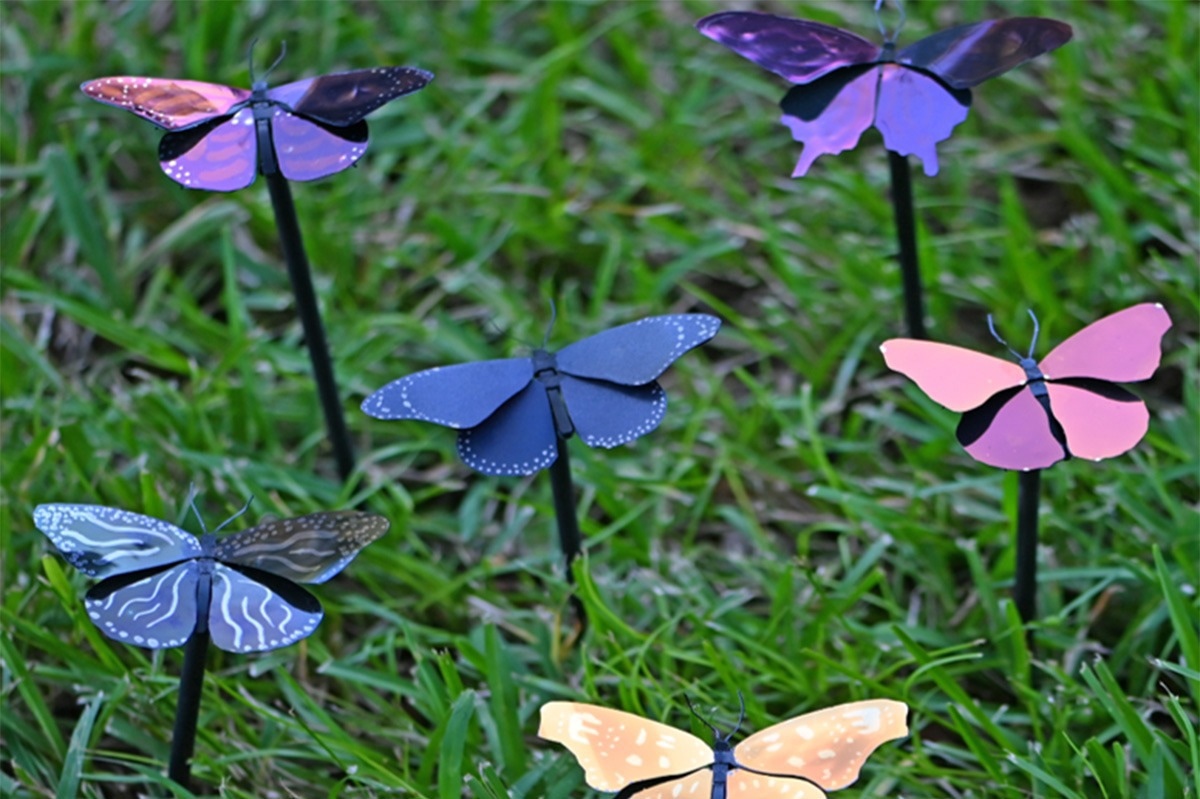Debashis Chanda, a professor and researcher in the NanoScience Technology Center of University of Central Florida, was inspired by butterflies to develop the first eco-friendly, multicolor, and large-scale substitute to pigment-based colorants, which could help decrease global warming and contribute to energy-saving efforts.
 The UCF-developed plasmonic paint uses nanoscale structural arrangement of colorless materials—aluminum and aluminum oxide—instead of pigments to create colors. Here the plasmonic paint is applied to the wings of metal butterflies, the insect that inspired the research. Image Credits: University of Central Florida
The UCF-developed plasmonic paint uses nanoscale structural arrangement of colorless materials—aluminum and aluminum oxide—instead of pigments to create colors. Here the plasmonic paint is applied to the wings of metal butterflies, the insect that inspired the research. Image Credits: University of Central Florida
The results were published in Science Advances.
The range of colors and hues in the natural world are astonishing—from colorful flowers, birds, and butterflies to underwater creatures like fish and cephalopods. Structural color serves as the primary color-generating mechanism in several extremely vivid species where geometrical arrangement of typically two colorless materials produces all colors. On the other hand, with manmade pigment, new molecules are needed for every color present.
Debashis Chanda, Professor and Researcher, NanoScience Technology Center, University of Central Florida
The research team developed a plasmonic paint based on such bio-inspirations, which uses a nanoscale structural arrangement of colorless materials—aluminum and aluminum oxide—rather than pigments to make colors.
As pigment colorants regulate light absorption depending on the pigment material’s electronic property and hence all colors require a new molecule, structural colorants regulate the way light is scattered, reflected, or absorbed purely based on the nanostructures’ geometrical arrangement.
Those structural colors are eco-friendly because they only use oxides and metals, contrary to the existing pigment-based colors that employ artificially synthesized molecules.
To create long-lasting paints of every color, the scientists have combined their structural color flakes using a commercial binder.
Normal color fades because pigment loses its ability to absorb photons. Here, we’re not limited by that phenomenon. Once we paint something with structural color, it should stay for centuries.
Debashis Chanda, Professor and Researcher, NanoScience Technology Center, University of Central Florida
Besides, as the entire infrared spectrum is reflected by plasmonic paint, minimal heat is absorbed by the paint, which results in the underneath surface remaining 25 to 30 °F cooler than it would if it were covered with standard commercial paint, the scientist states.
“Over 10% of total electricity in the U.S. goes toward air conditioner usage,” Chanda adds. “The temperature difference plasmonic paint promises would lead to significant energy savings. Using less electricity for cooling would also cut down carbon dioxide emissions, lessening global warming.”
He also notes that plasmonic paint is extremely lightweight; only around 3 pounds of plasmonic paint would be needed to cover a Boeing 747, which would need over 1,000 pounds of traditional paint.
Future Research
Chanda declares that the future steps in the project involve exploring the paint’s energy-saving factors to enhance its viability further as commercial paint.
“The conventional pigment paint is made in big facilities where they can make hundreds of gallons of paint. At this moment, unless we go through the scale-up process, it is still expensive to produce at an academic lab. We need to bring something different like, non-toxicity, cooling effect, ultralight weight, to the table that other conventional paints can’t.” Chanda concludes.
Journal Reference:
Cencillo-Abad, P., et al. (2023) Ultralight plasmonic structural color paint. Science Advances. doi.org/10.1126/sciadv.adf7207.